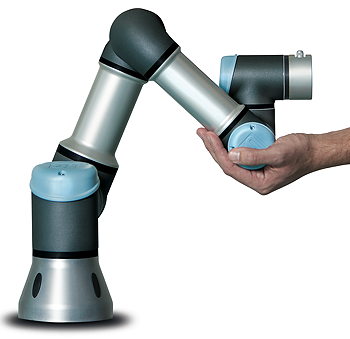- Home » News » Technology News
Six-axis table-top robot gives a ‘third hand’ to workers

The Danish robot-maker Universal Robots has announced a compact, six-axis, table-top robot that weighs just 11kg, but has a payload of 3kg, 360-degree rotation on all wrist joints, and infinite rotation on the end joint. The company claims that these characteristics make the UR3 robot, the most flexible, lightweight, table-top robot available that can work safely alongside humans.
“With the UR3, table-top automation is easy, safe and flexible,” says Universal Robots’ co-founder and chief technology officer, Esben Oestergaard. “A single worker can accomplish what traditionally would be a two-person task by having the UR3 robot as a third-hand helper. It’s an ideal choice for applications that require six-axis capabilities where size, safety and costs are critical.
“UR3 is an optimal assistant in assembly, polish, glue, and screw applications requiring uniform product quality,” he adds. “Our new robot can also be used in a separate workstation mounted on the table, picking, assembling and placing parts in optimised production flows. Because of its compact form and easy programming, it’s easy to switch between tasks to meet agile manufacturing needs, making total cost of ownership low and payback periods fast.”
Universal Robots expects the new machine to be used in applications such the manufacturing of medical devices, circuit boards and electronic components. The robot can pick up screws, mount and tighten them applying the correct torque. In gluing applications, it can dose exactly the same amount of glue with constant and steady pressure along a narrowly defined path.
“A big demand driver will be automating production in confined environments,” predicts Oestergaard, who led the three-year-long programme to develop the new robot. “With the UR3, we can now fit a six-axis robot into more assembly and manufacturing lines where erecting large safety enclosures would not be feasible. The UR3 is ideal for relieving employees from working in environments with toxic or hazardous materials, and that scenario will also drive the adoption of UR3 robots.

“With the larger UR5 and UR10 robots, we see end-users integrating our robot arms in applications and industries that we didn’t initially expect,” he admits. “I’m sure we will be equally surprised to witness the adaptation of the UR3 into new scenarios where robots haven’t ventured before.”
The UR3 has 15 adjustable safety settings. One of these is a force-sensing setting that limits the forces at contact if the robot collides with an employee. It has a default force setting of 150N but can be set to stop if it encounters a force as low as 50N.
The new robot has the same 0.1mm repeatability as the UR5 and UR10 robots and can follow the outline of a surface by “feel” rather than through programming precise movements and coordinates, which could require more than 100 data points to be programmed into an application.
The UR3 has a reach of 50cm. Its modular design allows joints to be exchanged in less than 30 minutes, if necessary.





